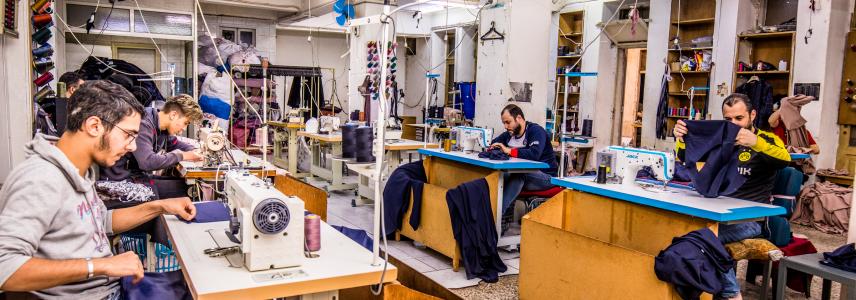Running an apparel factory in times of COVID-19

Perhaps it should not have come as such a surprise but it did. The coronavirus outbreak began at the end of December last year and today, it has paralyzed much of the world. Europe has quarantined itself. This has an immediate negative effect on manufacturers that supply to European customers. Is there anything you can do as an apparel manufacturer?
Most of Europe is currently in ‘lockdown’, just like many other parts of the world. This has an huge negative impact on consumer spending across the economy, including the apparel sector. Online retail has compensated some of the physical sales, but hardly all. Small businesses especially have tried to switch to home-delivery, but fashion seems to have little priority for consumers right now.
Cancelling orders
Many European fashion companies have put all their orders on hold or have even cancelled them. This greatly affects apparel producing countries, many of which are experiencing a lockdown of their own. As Sourcing Journal described: “in a week’s time, $1.5 billion worth of already placed orders have been cancelled in Bangladesh, potentially putting more than four million workers at risk.” British newspaper The Guardian reported that 1 million garment workers have already been sent home in Bangladesh because of cancelled orders.
Even if the virus outbreak is under control by summer and the economy opens up again, the industry will face another problem. European fashion retail has missed the spring/summer season and will enter the winter season with mostly spring/summer stock. This means that companies will need new merchandise quick.
How to adjust
Fashion companies may place small orders with a fast delivery date. If you are an apparel manufacturer, try to prepare for that situation as much as you can. Using stock fabrics would be the smartest move. Make sure you have a database of all stock fabrics available within your company. Also check the available stock at your fabric suppliers.
Meanwhile, keeping your factory up and running will be very challenging. Perhaps you have the possibility to start manufacturing personal protective equipment (PPE), which is in high demand now. Check, for example, how the European Apparel and Textile Federation (EURATEX) is trying to organise the supply of PPE worldwide, including 89 million face masks. In case of cancelled orders or stock, turning to the local or regional market is the only option to sell and get back part of the invested money.
Life after coronavirus
How can we prepare ourselves for a similar crisis in the future? First, everyone in a supply chain should be able to make a fair profit and build reserves for difficult times. Unfortunately, this is not always the case in the international apparel industry. While many factories have increased their service level in recent years, they have been under continuing price pressure. In the future, try to factor in a reasonable profit in your Free on Board price (FOB), so you can build up your reserves.
Another possible way to reduce risk for all actors in the apparel supply chain is by reducing stock. In an ideal scenario, you start production only after the end-consumer has bought and paid for a product. Unrealistic? There are already examples of consumers waiting 4-8 weeks for delivery after they have bought something. For instance, many consumers await the fashion sales season to buy items that they will only wear half a year later. Made-to-measure, a small but growing niche in the fashion sector, is based on the same principle.
Staying up to date on the situation in Europe
You can check the number of coronavirus cases worldwide on Worldometer. Various European countries including Italy, Spain, France, Austria and Denmark have begun considering easing the restrictions as the rise of COVID-19 cases has been slowing. To stay updated on policy responses to the virus outbreak in the six biggest European apparel markets check the following links:
- France’s COVID-19 restrictions will last until at least 15 April. Check gouvernement.fr for official news about France’s coronavirus policies.
- Germany will not lift COVID-19 restrictions until at least 20 April. Check the website of the German ministry of health for more information.
- The UK’s COVID-19 restrictions will last until at least Monday 13 April. Check gov.uk for more information about coronavirus policies in the UK. The UK Fashion & Textile Association (UKFT) has a website dedicated to their support for British fashion retailers during the coronavirus crisis.
- Italy’s restrictions will last until at least Monday 13 April. The official government website has information only in Italian, but daily newspaper La Stampa has a section in English that is regularly updated.
- Spain will not lift COVID-19 restrictions until at least Monday 27 April. The official website of the Spanish ministry of health is available only in Spanish, but daily newspaper El Pais has a section in English that is regularly updated.
- The Netherlands will not lift COVID-19 restrictions until at least 28 April. Check government.nl for more official information about coronavirus restrictions in the Netherlands.
For an overview of policy responses in different EU countries, visit euobserver’s coronavirus response page. Newspapers and industry websites such as The Financial Times and The Business of Fashion report daily on the impact of the crisis on fashion retail in Europe and the US.
Stay informed
To stay informed on the latest developments in apparel make sure to subscribe to our newsletter.
This news article was written on behalf of CBI by Giovanni Beatrice and Frans Tilstra for FT Journalistiek.